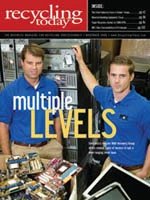Throughout the past several years, both buyers and sellers of commodities could agree on the word "volatile" to describe the state of the markets. There was often an implied difference, however. For sellers of materials, the volatility was cushioned by an upward pricing trend. For buyers, it was a double whammy of volatility combined with higher costs.
The late summer has brought an unmistakable turning of the tide. If commodities have been on a rollercoaster ride, several of them just plunged down the big hill—the one that causes all the screaming. Even industry veterans have been using the term "uncharted waters" to describe market conditions as they have unfolded in the fall.
The ferrous scrap market, hailed by former Federal Reserve Chairman Alan Greenspan in the past as a bastion of pure supply-and-demand economics, has provided a clear "Exhibit A" of the volatile situation.
In late July and early August, scrap grades traded at between $500 and $875 per ton, with buyers and sellers of scrap commenting upon a genuine strain on the supply of prompt grades (busheling and bundles) in particular. But as summer ended, export orders dried up, and domestic mills cut back melting schedules in response to slow vehicle sales and a dismal housing (and appliance) market.
The downhill coaster gained more momentum as the credit crisis stirred in an element of distrust between some buyers and sellers and frustration on the part of some buyers who claimed they could not get letters of credit.
Much of this occurred while recyclers continued to receive material across the scale from a new generation of peddlers who were unaware that scrap prices could fall so quickly—or even veteran customers unaware of the rapid price drop.
By the third week of October, ferrous scrap recyclers joined steel mills and service centers with excess inventory, creating an entire supply chain scrambling to adjust to dramatically different market conditions.
Some scrap recyclers have cut back scale hours and stopped seeking out scrap. Peddlers have had to reconsider whether it remains worth their time and effort to collect items. Auto wreckers are beginning to inventory auto hulks, and demolition contractors must scramble to reconsider the merits of steel-intensive projects.
The ferrous scrap rollercoaster has plunged in a hurry. A number of factors (credit market reinvigoration, China’s economy and consumer confidence in the U.S. among them) will determine whether the coaster rests in the trough, begins to glide along at a slightly steadier pace or even begins to head back uphill for another volatile swing.
While in the midst of the gloom, that last scenario seems unlikely, it has proven unwise to be completely convinced that one knows where the coaster will go next.

Explore the November 2008 Issue
Check out more from this issue and find your next story to read.
Latest from Recycling Today
- NWRA announces 2025 Driver of the Year, Operator of the Year winners
- The Scrap Show: Nanci Schuld of FE Trading Group LLC
- Call2Recycle Canada partners with RLG to advance battery collection
- Report delves into recovery opportunities for food-grade polypropylene
- Reimagining Supplier Payments in Metal Recycling: A Digital Leap Forward
- STEINERT Lithium Battery Detection and Removal from Waste Streams
- Driving the Future: Innovations in Waste & Recycling Technology
- Robin Wiener recognized for recycling leadership





